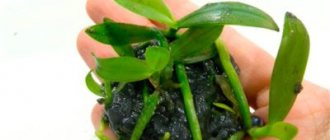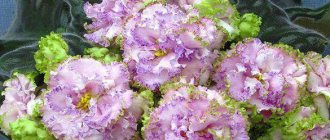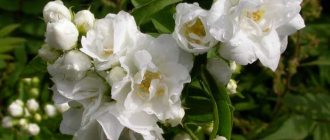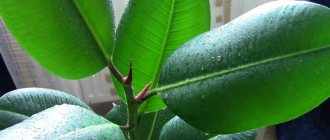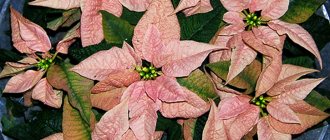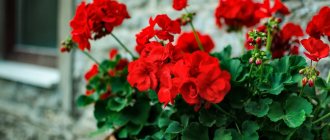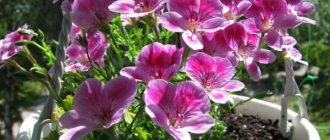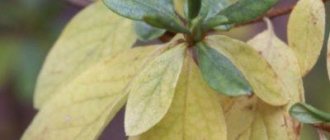Botanical description
Garden balsam is a herbaceous flower, a representative of the Impatiens genus. If you translate this flower into Latin, you get “impatient.” As a rule, it blooms in summer until August, when the fruits appear. The fruit capsules curl when they bloom and small seeds fall to the ground. They jump out in different directions up to two meters in diameter.
Impatiens for garden plots is a poisonous plant ! This is worth considering if children often play on the ground and animals run around.
Proper seed preparation
It is difficult to achieve uniform germination and growth of balsam. Germination may take 1 to 2.5 weeks. Proper seed treatment before planting will help speed up this process and improve germination rates:
- A day before planting, the seed material must be pickled - disinfected in a pale pink solution of potassium permanganate for 10-15 minutes.
- Soak in a growth stimulator or immunomodulator.
- Pour warm, settled water over the seeds for 18–20 hours. Dry before sowing.
Balsam seeds are large and can easily be placed in a planting container. It is important to remember that they cannot be buried; sowing must be superficial.
History of origin
This flower was brought to Europe in the 16th century.
He lived in the tropical forests of Africa, on its eastern shores. The plant can also be found in India, England and Ukraine. At first, decorative varieties specially grown for pots were especially popular. Later, people became acquainted with street varieties of balsam, which took root on plots of land and received their local name - Wet Vanka. This name appeared due to observations of balsam. Flower growers have noticed that with high humidity, droplets of water form along the edges of the leaves. This liquid is secreted by the plant itself. Now balsam is very common throughout our homeland, especially in western and eastern Siberia.
Description of Impatiens or Impatiens
The plant consists of one- and two-year-old flowers and shrubs, reaching from 20 to 1 m in height. Shiny fleshy leaves with sharp toothed edges, shaped like an oval. There are about 500 species in nature, and breeders have developed the most resistant varieties to our climatic conditions, resistant to pests and diseases.
Hybrids have both simple and velvety flowers of purple-pink colors. Spurs form in the opened inflorescences, touching which after ripening causes a sharp eruption of seeds.
Currently, more than a thousand hybrid species of Impatiens are known; they are grouped into two main categories.
- Common Impatiens walleriana is one of the most common plants used to decorate public parks and gardens around the world. This herbaceous perennial plant is considered an annual in frost-free climates. Standard Impatiens are available in a variety of colors, grow best in full or partial shade and can reach up to 60cm in height depending on the variety.
- New Guinea balsam (Impatiens hawker)—also popular because of its higher sunlight tolerance—is a hybrid variety that produces larger, brighter colors than standard Impatiens. New Guinea balsam is mildew resistant and can grow up to 1m tall, with foliage in a variety of colors including green, purple and bronze. It is generally more difficult to grow from seed.
Appearance and characteristics
Garden balsam is very fragile . It has fibrous roots and a bright green, sometimes purple, spreading crown. Oblong leaves with small teeth, growing up to 10 cm long, make the plant beautiful even in the absence of flowers. The straight dark stem has many branches. Bright, predominantly red and yellow inflorescences, medium in size, have an irregular shape. A long nose forms in the middle of the flower.
Hybrid varieties have a wide variety of species and color palette. Today, experts represent about 400 species of this beautiful plant. There are dwarf species, and there are plants up to 120 cm in size.
Application in landscape design
Garden balsam is an ideal option for decorating the landscape; a continuous carpet of flowers of various colors and shapes will completely hide borders, ridges, and flower beds. It takes root well in indoor pots and flowerpots.
Designers use balsam as:
- balcony decoration;
- decor of terraces and gazebos;
- ground cover plant;
- decorations of flower beds and front gardens.
What is the difference between outdoor impatiens and indoor ones?
It is easy to distinguish garden balsam from its domestic relatives at first glance. No special knowledge required here. It grows outdoors and has a looser, almost transparent bush. This becomes especially noticeable if the plant is exposed to ultraviolet light. Garden varieties bloom predominantly in yellow shades, while indoor varieties have a huge variety of colors.
Street varieties are believed to have medicinal properties . Garden balsam is actively used in folk medicine and helps to cope with many ailments. The voluminous fleshy parts of the leaves contain ascorbic acid, many organic substances and flavonoids - substances of plant origin that have antioxidant properties. Domestic varieties do not have such features.
Another important difference between street balsam and home balsam is that the first flower is an annual. But its beauty and the lights of flowers scattered across the crown completely compensate for this shortcoming.
How to prepare seeds for planting?
Garden balsam seeds (photos of which are presented in the article) require careful care and proper preparation.
First of all, the seeds must be disinfected in a bright solution of potassium manganese or other liquid with disinfectant properties available on hand. The seeds are soaked in the solution for 15 minutes, then placed on a damp cloth to swell.
Several seeds are dropped into prepared, moistened holes and sprinkled with soil. The top of the soil is lightly sprayed and covered with cellophane. Under no circumstances should the soil be allowed to dry out or the temperature drop below 20 °C. After 1-1.5 weeks, when shoots appear, the film can be removed. In case of dense sowing, seedlings are pruned or thinned.
Varieties and photos of herbaceous plants
Of the 400 types of garden balsam, some varieties are especially popular.
Waller's flower
When flowering, Waller's balsam has almost no leaves visible, and the inflorescences cover almost the entire surface of the plant . The most common varieties of this type of garden balsam: Stardust, Kandy, Duet, Symphony.
Perennial hybrid: New Guinea
New Guinea balsam is a perennial hybrid resulting from the selection of certain species. So far there are no seeds of this plant species in our country. But it also has its own varieties: Java, Macarena, Mini Gini, Jungle Rain.
Non-ornamental plants of this species: Ferruginous, Common, Small-flowered, Balfour, Niamniam.
undersized
The low-growing type of balsam grows no higher than 15 cm . The dense collections of flowers are so abundant that they make the plant look like a single bouquet. It differs from its fellows in a rich variety of shapes and colors. Low-growing balsam blooms until the autumn frosts.
We invite you to familiarize yourself with other types and varieties of such a beautiful plant as balsam. We have prepared articles for you about wild, terry, ferruginous, ampelous balsam, as well as about the Tom Samb variety.
Plant nutrition
The garden balsam flower, a photo of which is presented in the article, begins to be fed three weeks after planting. Complex mineral fertilizers are best suited for this. If you feed the plant too often, the bush will begin to shed its leaves and bloom worse. Therefore, it is recommended to use only half the required dose of fertilizer or halve its concentration.
Feed balsam 2 times a month after watering. Sick and weakened plants should not be fertilized.
Features of planting in open ground
If a gardener wants to plant balsam on a plot of land in the garden, he must know some rules for growing and caring for the plant. To do this, you need to choose a place where there are scattered rays of the sun and a lot of shade. Such a place may be under a large tree crown, near the western wall of the house. The best time for planting is early spring. When the frosts have already gone and the temperature does not drop below at least 5 degrees. Young plants may die at zero.
If a gardener plants several bushes at once, then the distance between them must be at least 35 cm. The crowns need space for normal growth and development.
After planting, it is better not to immediately add any fertilizers or fertilizing to the soil. The plant must adapt to the new conditions and after two weeks you can add some nutrients.
The best place for planting will be the lake shore of a garden pool. Or maybe there is some kind of spring or living open fountain on the site. The plant loves humidity. Such a place will be ideal for its growth.
Lighting and place of flower beds in the garden
The most suitable place to plant this beautiful plant will be a shaded area. Direct rays of the sun can destroy the flower . Ultraviolet light burns the leaves, leaving terrible burns on them. The moisture-loving plant dries out before our eyes. Allow some light by protecting tree branches or larger plants nearby. It’s good if there is a river or any other body of water nearby. This will simplify watering, because balsam needs it very often.
Soil requirements
The best option would be loose, moist and slightly acidic soil. To plant balsam, you need to prepare a mixture of sand, peat and humus. It will be good to add leaf soil. The top layer of soil should always contain moisture, this means that the plant needs to be watered thoroughly.
Cuttings of shoots
It does not involve any costs to grow the material by propagation by cuttings. To do this, you need to save your favorite bush from last summer for the winter or buy it in a store.
To get elongated shoots at home, they should be left for a week in the dark, not forgetting about watering. Then the top and side branches with three internodes are cut off and placed in a glass of water.
It’s a good idea to cover it with a lid that fits the size, making a hole in it for the seedling. After about two weeks, roots will form on the tip of the stem dipped in water.
When the roots reach 2 cm in length, the cuttings can be transferred to a pot. The size of the bowl determines whether the plant will bloom: the smaller the pot, the more flowers.
Rules for caring for balsam bush
Garden balsam adapts perfectly to many conditions . Its care, in fact, consists only of abundant watering and removal of unwanted weeds that can survive the plant. In addition, regular weeding helps the soil remain loose and crumbly. This means that the root system breathes and develops perfectly. If summer days are particularly hot, watering should be done every evening. This needs to be done abundantly enough to thoroughly water the soil to a depth of 30-40 cm.
It is useful to fertilize balsam with substances rich in nitrogen and phosphorus. With a lack of these substances, the foliage becomes dull, the inflorescences become smaller, and various diseases appear.
Planting and care
Propagation and care are not difficult, so even novice gardeners can handle them.
In the garden, planting seedlings begins in the spring at the end of May, beginning of June, when the danger of frost has passed, at a distance of 35 cm from each other.
You can add a handful of peat and the same amount of sand to the prepared hole. Sprinkle with a solution of any remedy for diseases, according to the instructions.
Place the sprout in the designated area and sprinkle. Further care consists of keeping the soil moist - periodic watering, loosening and removing weeds.
Fertilize every 14 days with humic or other complex fertilizers throughout the entire growth period.
It is important to limit the use of nitrogen, this helps to increase the growth of green mass and reduce flowering.
To increase flower stalks, it is recommended to pinch the apical and lateral branches.
Common diseases and pests
Like any living plant, balsam also has its weaknesses and susceptibility to various parasites.
- Rot . These phytopathogenic fungi and bacteria affect balsam leaves if watering occurs too intensely and there is stagnation of water. Soil drainage will be the solution to this problem.
- Spider mite . It sucks the juice out of the plant and it withers in a matter of days. A soap solution that needs to be sprayed onto the flower from a spray bottle will help here. Chemical compounds are used only in extreme cases.
- Viruses . You can tell that a plant is infected with special viruses by the curling of its leaves. Yellow spots appear on the surface of the flower. The virus is usually caused by the presence of aphids. And it needs to be dealt with only with special chemical means.
Annual plants, such as balsam, are completely removed from the soil after flowering. This means that the chances of developing diseases and pests are minimized. This prevention will help avoid recurrence of infections in subsequent plantings.
There are also diseases that affect the plant . Here are some of the most common diseases.
- Leaves fall due to hypothermia or lack of light. The same problem can occur if the soil is too dry.
- The buds fall off because the soil was too dry or because the plant did not adapt properly during replanting.
- The stems are stretched due to lack of light.
- Weak flowering, sparse inflorescences, because there are not enough nutrients and fertilizing.
With proper care, this plant will not cause much trouble and will delight you with its health, beauty and splendor.
Home care
When growing balsam, special conditions and careful care are not required. The plant will be comfortable in any bright place in the room. “Sparks” do not like direct sunlight and dark corners. And the favorite habitat is considered to be window sills facing the east or southeast side. In a bright room, balsams can be placed between two windows, then the buds will be even brighter than on the open areas of the window sill. In the summer, flowers are taken out for a walk and placed in the fresh air. Balconies, terraces, gazebos, but sheltered from wind and rain, are suitable for this.
Impatiens respond gratefully to watering. Succulent stems require a lot of water, and in the absence of moisture, the plants begin to turn yellow and drop flowers. In summer, the flower is watered abundantly almost every day, preventing the earthen clod from drying out. Water is poured so much that it begins to appear in the pan, from where it is then removed. Good drainage during such water procedures will prevent the roots from rotting. In winter, watering is reduced to two to three times a week, but it is also undesirable to allow the soil to dry out. The plants need to be sprayed periodically, avoiding water getting on the open buds.
Phosphorus-potassium fertilizer
To fertilize balsams, complex fertilizer is used. The first time nutrients are added immediately after transplanting young plants into permanent pots. From spring to autumn during the growing season, the flower is fed twice a month. But don’t be too zealous with nitrogen fertilizers. A large number of them can lead to growth of stems and delayed flowering. The best choice during this period will be phosphorus-potassium fertilizers. In the period from autumn to spring, the amount of fertilizing is reduced to 1 time per month.
To stimulate the growth of new shoots and more luxuriant flowering, the balsam bush is pruned annually. They do this in the spring. The removed parts can be used for propagation by cuttings.
Why doesn't it bloom?
It also happens that a seemingly healthy and beautiful plant, not susceptible to pests and without any signs of disease, does not bloom. This means that even with perfect care, something went wrong. It is important to find out the cause and eliminate it. The reasons may be a lack or excess of light, watering, microelements, temperature changes and much, much more. All this has already been said above, and if all the conditions are met, then there is one more spare tip on the topic of balsam flowering.
Impatiens need to be trimmed in time and old, overgrown and too large shoots removed. This is necessary for the formation of new fresh branches, which will begin to produce abundant flowering.
Growing conditions
Impatiens thrive in shade: under apple trees or bushes. In the sun, their flowers fade and turn pale, but in the shade the color is more saturated.
They ideally grow on the shady side of the house, near the fence, and also perfectly decorate unsightly structures where other crops do not bloom without light.
Advice. When planting in open ground, choose quiet corners of the estate, protected from drafts and winds. This is due to the tenderness and fragility of the stems, which break easily.
Reproduction methods
There are two main ways to plant balsam.
Seeds
Seeds need to be collected when the fruits are ripe.- Plant seeds in shallow containers or boxes.
- Sprinkle a thin layer of soil on top and water.
- The container can be covered with film; such a greenhouse will allow the seedlings to germinate faster.
- It is better to place greenhouses in a dark and warm place.
- When the first shoots appear, you need to move the flower to a bright windowsill.
- Watering occurs frequently, but stagnation of water should not be allowed.
- After 20 days, the babies begin to be transplanted into separate pots. Disposable cups are perfect for this.
- The seedlings are fertilized and become stronger.
- The time has come to harden the plants and adapt them to environmental weather conditions. To do this, you need to take them outside more often to a shaded place with diffused rays of sun. It is better to return home at night.
- As soon as about 10 leaves appear on the seedlings, you can proceed to transplanting them onto garden soil.
- Pour water into the hole and root the balsam to the level of the first leaves.
Seeds sown in January will produce flowering bushes in May.
Bushes
- Dig up a finished bush 10-15 cm high. It is very important to leave a lot of soil on the roots so as not to break them too much.
- Pour water into a hole 20 cm deep and place the balsam on the bottom, carefully covering it with earth.
- In order for the bushes to take root as well and quickly as possible, a good option would be to take soil from the place from which they were moved. This soil needs to be mixed with the soil in the garden area. This will help avoid stress caused by sudden changes in soil composition.
Impatiens like earth that is slightly acidic . And such soil is produced by peat impurities.
Garden balsam combines a lot of beauty: beauty, benefits, healing properties. This flower will delight you all summer and will become a source of aesthetic pleasure for the whole family.
How to properly sow garden balsam seeds for seedlings
In order to properly sow balsam seeds for seedlings at home, you need to know agricultural technology and the tricks of the procedure, the main stages. Let's look at the preparatory stages and the event plan in more detail.
Selection of capacity
The ideal container for sowing garden balsam seeds is a wide and not very deep common box or bowl (for example, a food container). The most suitable height is 7-10 centimeters. But the width should be chosen based on the number of seeds you want to plant for seedlings. There is no need to be afraid to plant in a common container; balsam tolerates picking well, so later you can safely plant the seedlings.
However, there are no obstacles to planting balsam seedlings in individual plastic cassettes, cups, peat tablets, or pots. The optimal volume of products is 200 or 250 milliliters.
Advice! It is recommended to disinfect the container before sowing (with the exception of peat products). This can be done using a dark solution of potassium permanganate (potassium permanganate) or antiseptics.
Any container for growing seedlings at home (again, except for pots and peat tablets) must have drainage holes to remove excess moisture. If you don’t see them, be sure to do it yourself.
Soil preparation
To plant garden balsam seedlings at home, the soil should be light, loose, air- and moisture-permeable, moderately nutritious, and neutral.
But if you sow a flower crop in heavy, dense, too fertile soil containing organic components (compost, humus, manure), then the plants will be very uncomfortable. It is unlikely that you will be able to grow good balsam seedlings in such a substrate.
You can prepare the soil with your own hands at home; to do this, mix in the same ratio:
- peat;
- sand;
- perlite;
- turf land.
You can also make a soil mixture using the following recipe:
- soil from the garden (1 part);
- peat (1 part);
- sand (0.25 parts).
Then mix all the ingredients well and sift through a sieve with wide holes.
You can also plant balsam in purchased soil; ordinary universal soil for seedlings, preferably flower soil, will . But before use, it is recommended to improve its properties and structure. To do this, mix the mixture with a loosening element - perlite, vermiculite or sand.
Seed preparation
You can plant the seeds of this crop for seedlings without any preparation. However, it is still recommended to treat them - disinfect (etch) to eliminate pathogens of fungal and other diseases from their surface, and then, just before sowing, soak them in a growth stimulator.
disinfect balsam seeds in a solution of the biofungicide Fitosporin-M (according to the instructions for the drug), chlorhexidine (keep in the substance for 30 minutes) or aloe juice (mix juice and water 1:1, process for 30 minutes).
After dressing and before planting, you can soak the seeds in a solution of a growth stimulating drug , for example, Zircon, Epin-Extra and others. You must act strictly according to the instructions.
Such pre-sowing preparation will help to obtain more friendly and rapid germination of seeds in the soil, as well as stronger plants.
Master class on sowing balsam for seedlings
Having prepared the container, soil mixture and planting material, you can begin sowing balsam seeds for seedlings. The following instructions with step-by-step photographs will tell and show you how to do this correctly:
Step 1: Place drainage at the bottom of the container.
For example, small expanded clay, perlite, broken brick, some small stones. But you don’t need to make too large a layer, 1.5-2 centimeters is enough.
Step 2: Fill the container with soil.
But it is recommended to leave a small distance to the edges, literally 2 cm. If necessary, level the surface of the soil.
Step 3: Moisten the soil well with clean water.
Step 4: Sow the seeds.
As you can see in the photo above, the balsam seeds are quite large, so you can sow them with your fingers without any problems. But if it’s more convenient for you, you can plant it using a toothpick.
The optimal distance between balsam seeds when planting is 3 centimeters.
Important! Despite their large size, balsam seeds do not need to be buried or covered with soil. Surface sowing!
Step 5: Water evenly after planting.
Step 6: Cover the seedling container with a lid or film.
This stage is required to create greenhouse conditions that maintain high humidity and heat. They are necessary for seed germination.
Step 7: For convenience, label the bowl.
By the way! A good solution is to plant balsam seeds for seedlings in peat tablets. First of all, you need to soak the tablets in water and let them swell. Then you should put one seed in the center of the washer in a small depression, put it in a greenhouse and wait for the seedlings to germinate.
Popular types of Impatiens for the garden
This plant can be divided into two large groups: garden and indoor balsams. They have common features and growing requirements, but domestic species are less resistant to weather changes. Let us describe popular garden species.
Tom Thumb (Impatiens Tom Thumb)
Tom Thumb (Impatiens Tom Thumb)
A spreading balsam a quarter of a meter in height. Pleasant to the touch, lanceolate-serrate foliage frames velvety buds, which can be soft white, bloody, lilac, or pinkish in color.
Balsam Camellia (Impatiens Camellia)
It grows in the shape of a pyramid, formed from fleshy foliage and large 4 cm buds of milky, lilac shades or a compilation of them.
Waller's Impatiens (Impatiens walleriana)
The name unites several subspecies, differing in flower texture (simple or double), color scheme (all shades of red), petals (plain or with pale stripes).
Waller's Impatiens (Impatiens walleriana)
Their advantage is the shape of the bush - it is ideal for a gardener who is fond of topiary, as it often represents an almost perfect circle. Flowering occurs profusely during the warm period of the year.
Balsam Exotic (Impatiens Exotic)
A bush up to 15-20 cm with serrated-lanceolate leaves and burning buds of deep pink, soft lilac, lilac and all their various variations.
Garden balsam variety Carmelita
This is an annual crop that grows up to 0.7 meters. The flower is thermophilic, shade-tolerant, and moisture-loving. It is distinguished by large inflorescences of different colors. Flowering is observed from June to September.
New Guinea balsam (Impatiens hawker)
This group of hybrids is large in size, but there are small flowers. The height reaches up to 1 m cm. The leaves have a wide range of colors - from bronze to dark green, with a yellow center. The stem is usually reddish in color.
New Guinea balsam
This ornamental plant is presented in a variety of species, which will satisfy the aesthetic needs of the most demanding gardener. Lately, hanging balsam has become quite common. Among indoor balsams, we can distinguish varieties of terry balsam, popular among gardeners, such as Athena, Salsa Red White and others.
